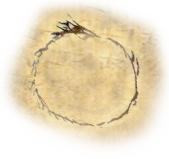Character Statistics
Play Vocabulary
Character Traits in Fairyland
At it's heart, the essence of a living creature or character in Fairyland is found to reside within an encrusted song - an hidden array of seven labelled embers - or more properly translated from the Elf-tongue, in-embers, that is 'numbers' - the core attributes; it's vitals, or 'vital statistics'. It's theme.
These embers or vital attributes might be said to be a distillation of the 'soul' of it's being. The proper term used in Fairyland is M'moatia, and it implies the crystalline mote or vessel that contains the creatures' resonance, and which enables it's subtle communication with The-Lands-We-Do-Not-See via the Thread of Anansi the Spiderwoman, who is known as The Owner of All Stories and the Mother of Fate.
Three of a character's seven vitals (considered 'outer' parts of the M'moatia) are related to physical expression, and the other four (being the 'inner' part of the being of the creature) are related to mental and spiritual aspects - it's numen.
Seven Core attributes (The M'moatia, a characters' vital statistics):
- Will/Wyrd (WILL/WYRD) ("Willpower","Purpose" and/or "Magic")
- Wisdom (WIS) ("Wits", "Intuition", "Common Sense", "Natural Reason")
- Brains (BRN) ("Intelligence". "Mind", "Abstract Reason")
- Charm (CHA) ("Persuasiveness", "Social Talent", "Authority", "Beauty")
- Guts (GTS) ("Constitution", "Grit", "Nervous System", "Immune System")
- Muscle (MSL) ("Strength", "Bodily Power", "Brute Force")
- Sinew (SIN) ("Agility", "Dexterity", "Nimbleness")
The values for each attribute usually range from 1 to 10, and provide an indication of proficiency, talent or power in each arena. For example, it is obvious that an old sage with a Wisdom of 5 is wiser than a foolish knight errant with a Wisdom of 2, and that a tavern brawler with a Strength of 6 will defeat the feeble old sage (having a Strength score of 1 or 2) at an arm-wrestling competition.
The table at Size and Scale enables one to appraise the particular values of each of a character's vitals.
Furthermore, these seven vital measurements are supported by additional small groups of auxiliary values, being either inherent or derived, and that fill out the description of the character.
The seven core vitals together represent the primary attributes or traits and specific advancements of the living creature or character (the soul of it's being), while it's auxiliary arrays of other inherent and derived values relate more to the creatures' manifestation and interaction with the outside world (the outward expression of it's being), and thus these latter are more closely related to the 'outer' three aspects of it's seven-fold M'moatia.
Inherent Attributes
These values are the secondary specifics of the creatures physical manifestation within it's environment. They are 'inherent' because they do not depend necessarily or specifically on the seven core attributes. A small creature might be stronger than a bigger creature, and so the Muscle vital alone is not a reliable indicator of creature size. Thus these additional inherent attributes enable the modeling of a greater variety of life-forms than just the seven basic attributes by themselves. The secondary inherent attributes are:
- Body Dice ('Life Stone'; ie. 'hit dice': d4, d6, d8 etc.)
- Size (via body-dice/class/type/background)
- Health (via class/type/backgrounds/level + Guts)
- Speed (class/type/backgrounds + Muscle)
- Climb (class/type/backgrounds + Muscle + Sinew)
- Swim (class/type/backgrounds + Muscle)
- Fly (class/type/backgrounds + Muscle + Sinew)
- Damage reduction ('DR', natural armour)
In a game based on alphabetic flash cards, each player character acquires many of these inherent attributes from the player's assigned or selected flashcard, and this augments the M'moatia of seven vital statistics, and fills out more of the character.
Derived Attributes:
The derived attributes are those that experienced players might not need to explicitly document on their notes or character sheet, since they are derivable from some combination of the previously defined attributes.
- Initiative (Sinew + talent bonuses)
- Defense ([1/2 inv. body dice size] + Sinew + [armour total])
- Touch Defense ([1/2 inv. body dice size] + Sinew)
The Defense attribute is the defensive ability of the creature - it's ability to evade harm. Players might prefer to roll dice to handle a defensive action their characters take, but the Master of Ceremonies might want to handle the other non-player characters, creatures and monsters more speedily, and thus set static 'armour level' or 'armour class' values for each type.
If the game is using the simplest play type, with only a basic d6 dice, then a creatures' static defense bonus can be calculated by starting with the average dice roll on that dice (either 2 or 3, depending on how accurately you want to treat the statistics of dice rolling), and then add the additional defensive bonuses that might apply, in terms of natural armour, or armour worn, and it's Sinew vital, which denotes it's ability to dodge and evade incoming attacks.
A characters' Memory ability is that of player playing the character, or his or her ability to document thoughts.
Generating a Character
[...] (refer, for now, to this document by the Old Sage)
Continue onward to Actions.
See also:
